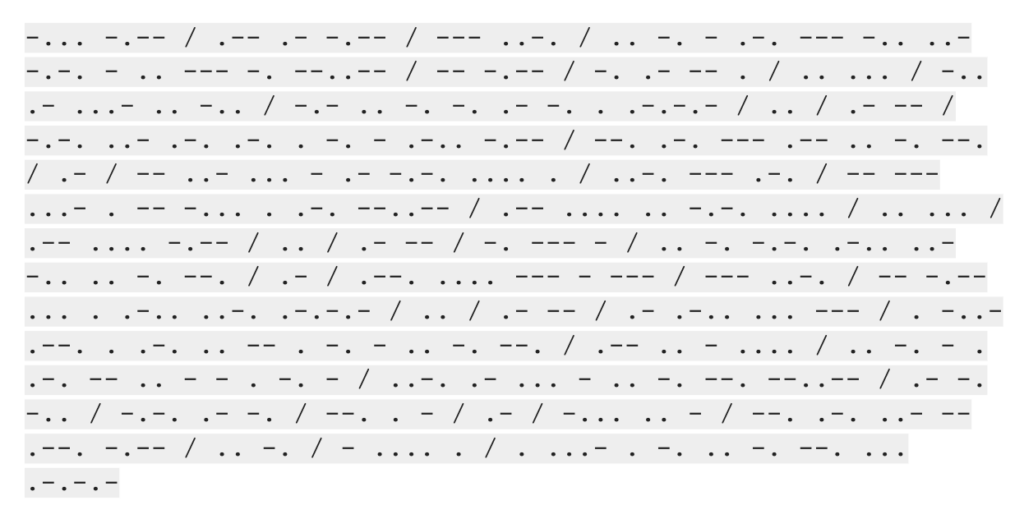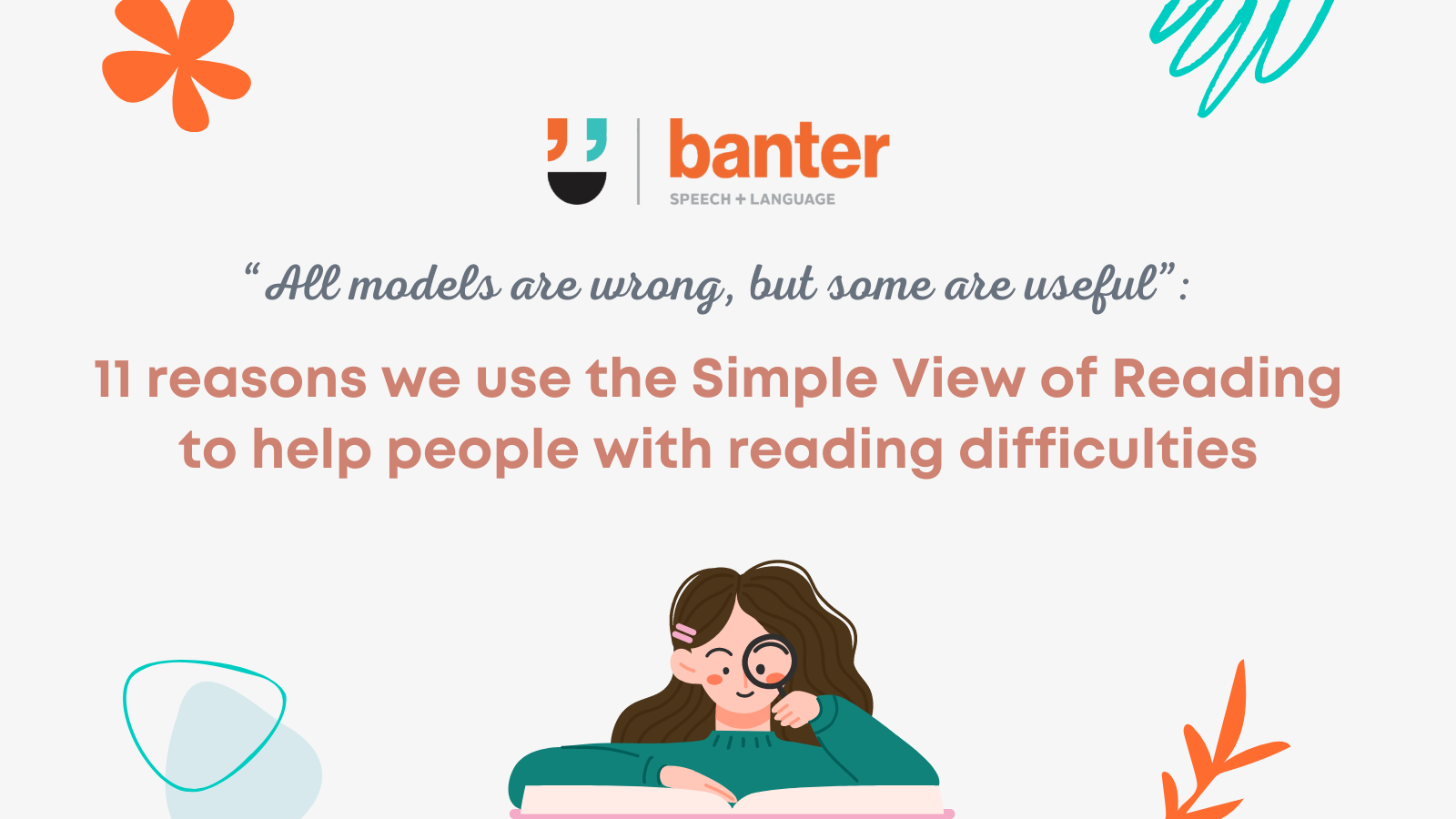Consider this magnificent paragraph:

Fascinating, right? But only if you know Morse Code.
Now, try this one:
Evenings the in grumpy bit a get can and, fasting intermittent with experimenting also am I. Myself of photo a including not am I why is which, Movember for moustache a growing currently I am. Kinnane David is name my, introduction of way by.
If you’re reading this blog, you can probably read every single word. But it takes a bit of work to make sense of the passage because of the language.
Now let’s reverse the paragraph above:
By way of introduction, my name is David Kinnane. I am currently growing a moustache for Movember, which is why I am not including a photo of myself. I am also experimenting with intermittent fasting, and can get a bit grumpy in the evenings.
This is easy stuff for any expert reader. Even many young school-aged children would understand what I’m talking about if I read them the passage aloud – although I might need to explain Movember to an international audience, and “intermittent” to many young folk.
Your experiences reading these three paragraphs illustrate The Simple View of Reading (SVR), originally proposed by Gough & Tunmer (1986).
The SVR says:
Reading comprehension = word recognition x language comprehension.
Our reading assessment and intervention practices are based on the SVR, and we’ve written about the model extensively, including here and here and here.
This year, the SVR has come under a bit of an attack by researchers who think the SVR is simplistic and outdated (e.g. Duke & Cartwright, 2021). These researchers would like teachers and others working in literacy to use a more complex model that includes additional variables, like executive functioning.
We read the criticism when it was published and were unconvinced – especially in light of the 2021 paper by Dolean and colleagues, which we summarised here. We’ve now had the benefit of reading a formal response by Hoover and Tunmer, and are even more satisfied with our conclusions.
Why we support and use the SVR
For 11 main reasons, the SVR remains a useful reading model for teachers, speech pathologists, and others working to help students with reading difficulties:
- Weight and quality of evidence: The conclusions implied by the SVR have been supported by over 150 studies, involving a range of readers, including beginners, experts, children, adults, people with different social-economic statuses and reading languages (e.g. Hoover & Tunmer, 2020; Dolean et al., 2021).
- Easy to explain and understand: The SVR is easy to explain to families, students and other clients with reading difficulties. We’ve even made a short video about it to spread the word: What I think about when I meet a child who can’t read.
- Focused on testable capacities (not invisible processes):
- Capacities are about abilities – what you can do – like the ability to recognise printed words and to understand their meaning. These are things you can observe and assess when working with a real life student.
- Processes are cognitive operations underpinning reading, including things like the mechanisms for converting light patterns that reach the eye from a page of print into a sequence of letter patterns, then translating them into phonological representations, and then into links to the brain’s knowledge of words. These processes are important and interesting – I love reading about them. But, in a school or clinic, you can’t easily see or measure isolated cognitive processes.
- Focus on proximal causes: The SVR focuses on the two main proximal capacities that underlie reading success – the variables of closest origin that we know directly affect reading comprehension.
- Clarity: The SVR implies that:
- both word recognition and language comprehension are necessary for reading; and
- neither skill is on its own sufficient to create good reading comprehension; and
- you can’t compensate for poor decoding with good oral language skills, or vice versa. (A limitation in either or both skills will necessarily constrain reading compensation, i.e. multiplying anything by zero gives you zero.)
- Helpful for assessment planning and interpretation: The SVR implies that there are three main kinds of reading difficulties:
- an inability to recognise words quickly, e.g. because of limited decoding skills;
- an inability to comprehend language, e.g. because of vocabulary deficits and/or knowledge limited language structures; or
- both.
This reminds us to test both word recognition and oral language skills and to look for patterns of deficits. We have written more about this here and more about the differences and overlaps between Developmental Language Disorder and Dyslexia here.
- Helpful for teaching: The SVR helps education and health professionals working with people with reading difficulties to identify and focus on the most important things at the time for the development of each student’s reading comprehension skills, recognising that:
- when decoding skills are very poor, they act as a bottleneck on reading comprehension; and
- when decoding skills are stronger, language comprehension becomes a more important influence on reading comprehension.
- Parsimony: When the evidence for a complicated interpretation is weak or lacking, the simplest interpretation should be preferred. Occam’s Razor tells us that, in explaining a thing, no more assumptions should be made than are necessary. Recent evidence shows that a reader’s combined abilities to understand a language and to quickly and accurately identify its printed words accounts almost completely for the ability to read in the language (e.g. Dolean et al., 2021). We shouldn’t introduce more variables into the mix unless inclusion would explain things that the SVR cannot explain. This is not (yet) the case.
- Opportunity costs: We have limited time and resources to work with children with reading difficulties. We need to spend that precious time working on things that we know improve reading comprehension outcomes, rather than things that might, or might sometimes.
- Specificity: If you want to get better at reading, you should work directly on reading-specific skills, and not on general processes thought to underpin them. For example, to date, there is insufficient evidence that working memory training transfers to improvements in language or reading comprehension; or that executive functions training is more efficient in improving reading comprehension than intervention designed to improve word recognition and/or to support language comprehension.
- Resisting shiny new object syndrome (or progress for progress’ sake): Will Durant, the famous historian, warned us to avoid what he called the “fetish of novelty”, noting that people tend to exaggerate the value of new ideas and things. Discarding a tried and tested mental model like the SVR simply because it’s been around a while doesn’t make sense. In fact, it runs counter to the Lindy effect: the theory that the future life expectancy of an idea is proportional to its current age, so that every additional period of survival implies a longer remaining life expectancy.
When the facts change…
None of this suggests that we will always support the SVR. If the facts change, e.g. because of significant, compelling, high quality, independent, new peer reviewed research showing the SVR is incorrect or incomplete in a material way, we will change our mind and embrace an augmented SVR or new model that helps our clients maximise their reading comprehension gains.
The SVR itself continues to evolve with new research. For example, the original SVR referred to decoding, rather than word recognition as one of the two main factors involved in determining reading comprehension. The SVR was updated to be neutral on how word recognition is achieved, e.g. indirectly through grapheme-phoneme correspondences, or more directly through orthographic mapping. (You can read more about the very complicated dual stream models of reading here.)
In the final analysis, the SVR is just a model to help us to help people with reading difficulties. Shane Parrish reminds us that the Map Is Not the Territory – models are not reality. As George Box is reported to have said:
“All models are wrong, but some are useful.”
The SVR might not be perfect. It will almost certainly be updated and improved as new research is published e.g., on important topics like motivation and engagement. It may even, one day, be discarded and replaced with a new model. But, for now, it’s far too useful to throw over for a more complicated, less tested, and less useful set of ideas.
Principal sources:
- Hoover, W.A., and Tunmer, W.E. (2021). The Primacy of Science in Communicating Advances in the Science of Reading. Reading Research Quarterly: https://ila.onlinelibrary.wiley.com/doi/full/10.1002/rrq.446
- Duke, N.K., & Cartwright, K.B. (2021). The science of reading progresses: Communicating advances beyond the simple view of reading. Reading Research Quarterly: https://ila.onlinelibrary.wiley.com/doi/full/10.1002/rrq.411
Related articles:
- Too many children can’t read. We know what to do. But how should we do it?
- What I think about when I meet a child who can’t read
- What are the priorities for early reading instruction: should we work on executive functions or focus on word decoding and oral language skills?
- “I don’t understand what I’m reading” – reading comprehension problems (and what to do about them)
- Oral language: what is it and why does it matter so much for school, work, and life success?
- Dyslexia vs Developmental Language Disorder: same or different, and what do we need to know about their relationship?
- Beginning readers’ brains are not the same as skilled readers’ brains, so stop teaching beginners to read like they are adult experts
- Is your child struggling to read? Here’s what works

Hi there, I’m David Kinnane.
Principal Speech Pathologist, Banter Speech & Language
Our talented team of certified practising speech pathologists provide unhurried, personalised and evidence-based speech pathology care to children and adults in the Inner West of Sydney and beyond, both in our clinic and via telehealth.

